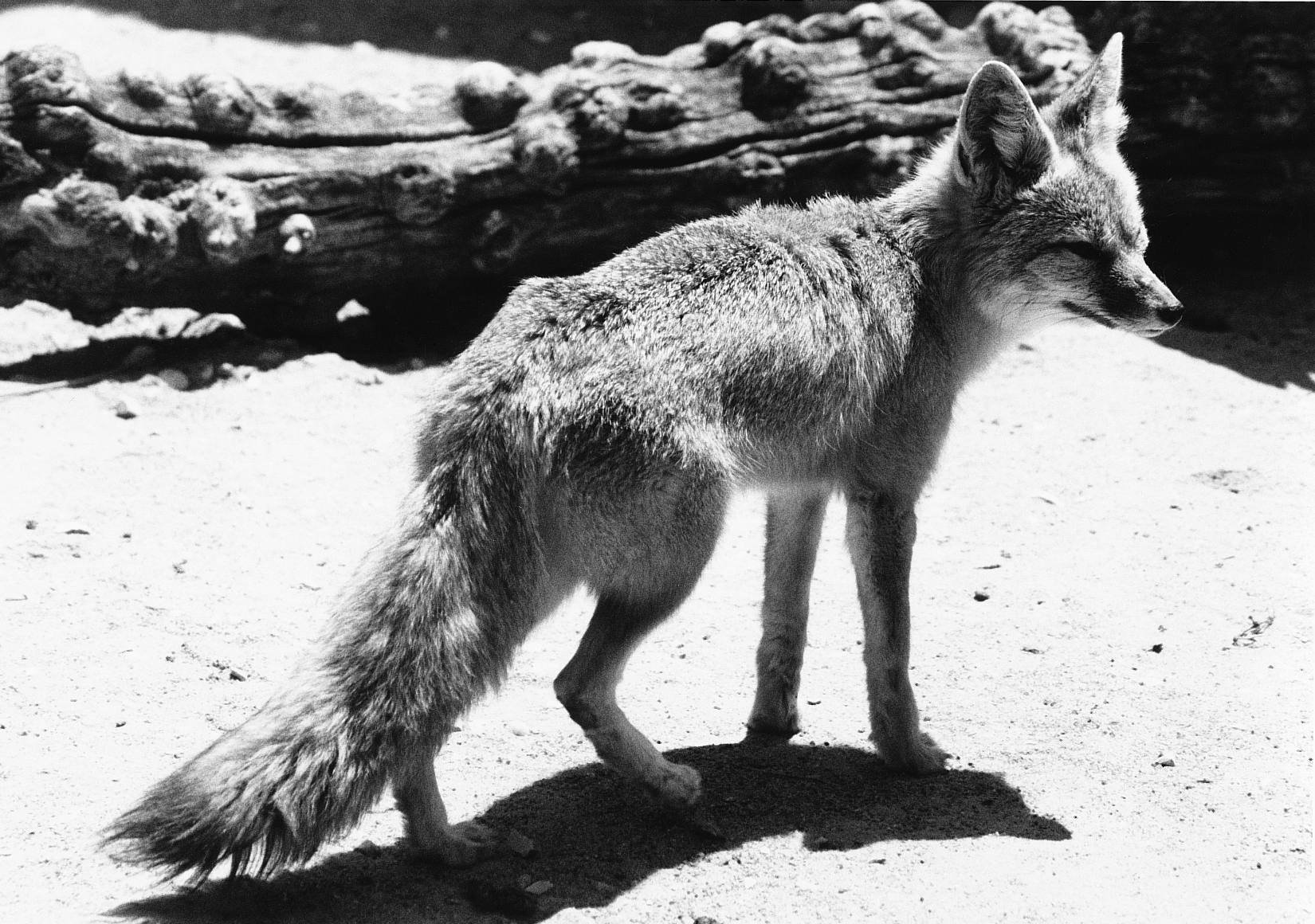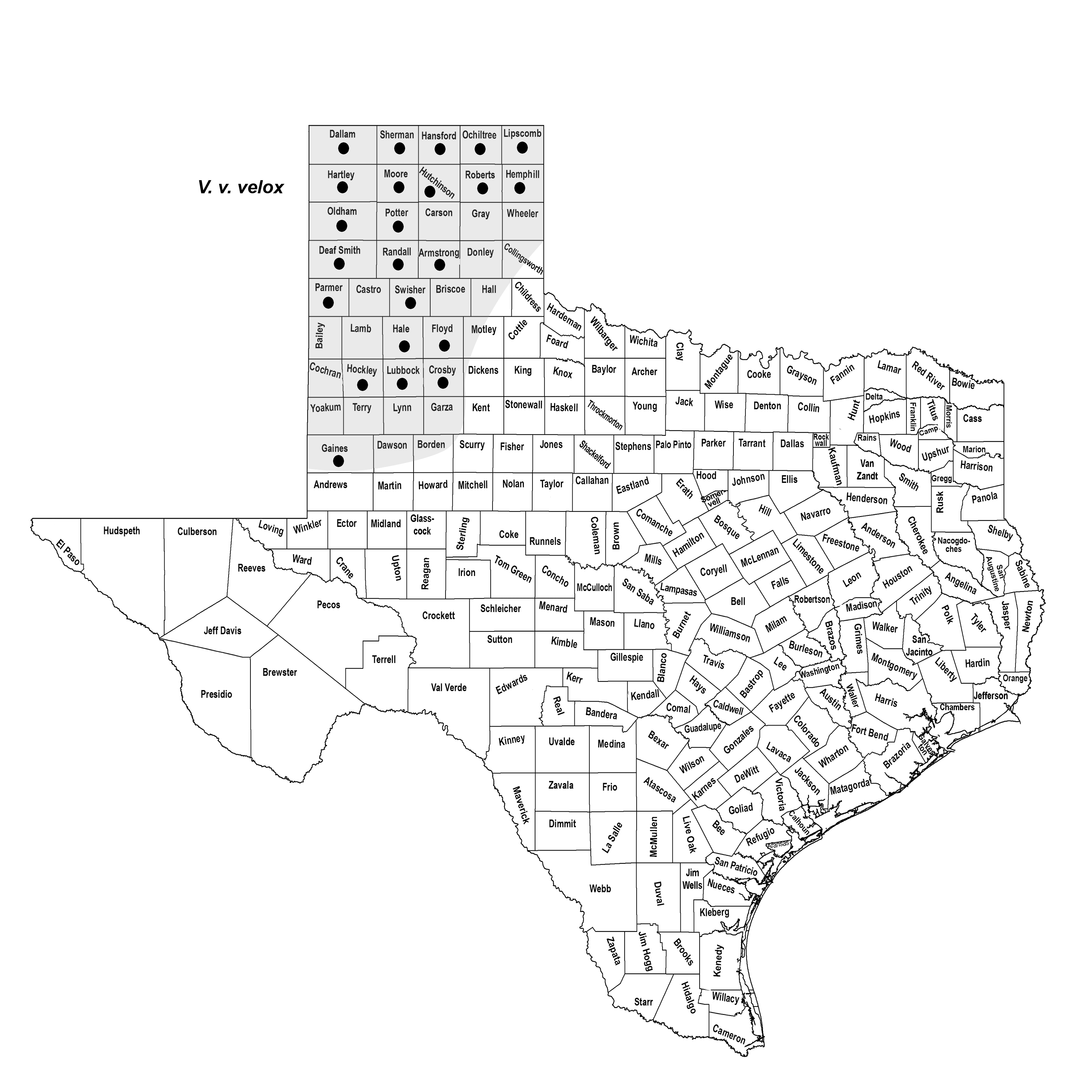SWIFT FOX
Vulpes velox (Say 1823)
Order Carnivora : Family Canidae
DESCRIPTION. A small fox with upperparts buffy gray; sides and legs orange tan; tail buffy gray with black tip; underparts whitish to buff. Very similar in appearance to the kit fox (Vulpes macrotis), differs by having smaller ears (generally <75 mm) that are set farther apart at the base, auditory bullae smaller, head narrower, and tail slightly shorter. Dental formula: I 3/3, C 1/1, Pm 4/4, M 2/3 × 2 = 42. Averages for external measurements: total length, 790 mm; tail, 270 mm; hind foot, 130 mm; ear, 65 mm. Weight, 2–3 kg.

DISTRIBUTION. Known from Panhandle region south to Howard, Martin, and Monahans counties.

SUBSPECIES. Vulpes v. velox in the Panhandle and Llano Estacado regions.
HABITS. Like the kit fox, swift foxes are about the size of an average house cat. They live in the short and mixed-grass prairie regions of the Llano Estacado. They usually den and hunt along the borders of valleys, sparsely vegetated habitats on sloping plains, and on hilltops. They share many of the same habits and ecology of the kit fox.
The diet of swift foxes consists largely of small mammals, particularly rodents, but also includes insects, small passerine birds, lizards, amphibians, and fish. Known food items are kangaroo rats, jackrabbits, cottontails, small birds, and insects. In 1958, William L. Cutter examined 12 stomachs and 250 scats (droppings), collected mainly in late spring, summer, and early fall, to determine the food habits of these foxes. Cottontails and jackrabbits were found almost as frequently (60 times) as all other vertebrates combined (68 times). Small rodents occurred 26 times; passerine birds 33 times; lizards 4 times; and fish 3 times.
Male and female foxes establish pair bonds during October and November, during which time large family dens are used. These foxes are monogamous for a breeding season, but the pairs are not necessarily the same from year to year. Breeding occurs from December to January, and most litters are born in March or early April. Litter size ranges from three to six, and the swift fox is monestrous. Cutter observed that in the Texas Panhandle (Hansford County) these foxes usually den in open, overgrazed pastures. Of 25 occupied dens that he observed, 19 were located in pastures, 2 were in plowed fields, and 4 were along north–south fencerows. The den is a simple structure with more than one opening. One that Cutter excavated had a circular entrance 20 cm in diameter and a 378 cm length of open, underground tunnel. The main chamber was 30 cm wide, 22 cm high, and 80 cm below the surface of the ground. In 2005, Brady McGee and colleagues collected data from 30 swift fox dens and noted that the most distinguishing feature, relative to other fox dens, was the size of the "dirt tailings." These tailings are the result of den digging or expansion, and swift foxes may use these as a visual cue for a rapid escape into the den.
POPULATION STATUS. Rare. This species occurs only in the Panhandle and Llano Estacado portion of the state. Swift foxes occupy approximately 40% of their historic range and these populations are often fragmented.
CONSERVATION STATUS. The IUCN lists the swift fox as a species of least concern. Swift foxes do not appear on the federal or state lists of concerned species. Similar to the kit fox, populations were decimated by indiscriminate poisoning campaigns directed at wolves and later coyotes. Populations appear to be increasing in some areas, presumably as a result of the Conservation Reserve Program. There is a need to carefully monitor the status of this species.
REMARKS. As discussed in the prior account, the swift fox (Vulpes velox) and the kit fox (Vulpes macrotis) have been regarded at times as one species or as two similar but separate species.
From The Mammals of Texas, Seventh Edition by David J. Schmidly and Robert D. Bradley, copyright © 1994, 2004, 2016. Courtesy of the University of Texas Press.
Natural Science Research Laboratory
-
Address
Museum of Texas Tech University, 3301 4th street, Lubbock, TX 79409 -
Phone
806.742.2486 -
Email
nsrl.museum@ttu.edu

